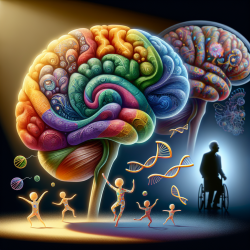Introduction
The intricate dance of development and aging in the human brain is orchestrated by a myriad of molecular mechanisms. Among these, microRNAs (miRNAs) have emerged as crucial regulators, influencing gene expression and playing pivotal roles in both brain development and aging. A recent study titled Unraveling the characteristics of microRNA regulation in the developmental and aging process of the human brain sheds light on the significant impact of miRNAs across the human lifespan. This blog explores how practitioners can harness these insights to enhance therapeutic outcomes for children.
Understanding MicroRNA's Role
MicroRNAs are small non-coding RNAs that regulate gene expression by targeting messenger RNAs (mRNAs) for degradation or translational repression. This regulatory function is crucial during brain development, where miRNAs contribute to neuronal differentiation, synaptic plasticity, and overall brain architecture. The study by Li et al. (2013) reveals that age-related miRNAs exhibit distinct topological features and have a higher degree of regulatory influence compared to non-age-related miRNAs.
Key Findings
- Age-Related Synergy: Age-related miRNAs tend to work in synergistic modules, indicating that they co-regulate target genes more effectively. This synergy suggests a complex regulatory network that could be targeted for therapeutic interventions.
- Network Characteristics: The miRNA-mRNA regulatory network constructed in the study highlights the scale-free nature of miRNA interactions, suggesting a robust framework that can adapt to various developmental and aging challenges.
- Developmental and Aging Continuum: The research underscores the continuum between developmental and aging processes, with miRNAs playing a central role in bridging these phases.
Implications for Practitioners
For practitioners in speech-language pathology and related fields, these findings offer a data-driven approach to understanding and potentially influencing brain development and aging. Here are some practical applications:
- Targeted Interventions: By identifying key miRNAs involved in brain development, practitioners can develop targeted interventions that may enhance neurodevelopmental outcomes in children.
- Early Detection: Understanding miRNA profiles could aid in the early detection of developmental delays or neurodegenerative conditions, allowing for timely interventions.
- Personalized Therapy: The insights into miRNA networks can inform personalized therapeutic strategies, tailoring interventions to the unique genetic and molecular profiles of individual children.
Encouraging Further Research
While the study provides a comprehensive overview of miRNA regulation, it also opens avenues for further research. Practitioners are encouraged to delve deeper into the molecular underpinnings of miRNA functions and their implications for child development. Collaborative research efforts could focus on:
- Expanding the miRNA-mRNA network to include more diverse populations and developmental stages.
- Exploring the therapeutic potential of modulating miRNA activity in neurodevelopmental disorders.
- Investigating the role of miRNAs in specific speech and language disorders.
Conclusion
MicroRNAs offer a promising frontier in understanding and influencing brain development and aging. By integrating the insights from this study into practice, speech-language pathologists and other practitioners can enhance their interventions, ultimately leading to better outcomes for children. To read the original research paper, please follow this link: Unraveling the characteristics of microRNA regulation in the developmental and aging process of the human brain.










